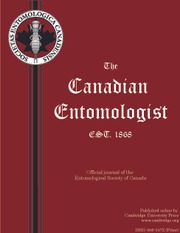Crossref Citations
This article has been cited by the following publications. This list is generated based on data provided by
Crossref.
Marchioro, Matteo
Rassati, Davide
Faccoli, Massimo
Van Rooyen, Kate
Kostanowicz, Chantelle
Webster, Vincent
Mayo, Peter
Sweeney, Jon
and
Fettig, Christopher
2020.
Maximizing Bark and Ambrosia Beetle (Coleoptera: Curculionidae) Catches in Trapping Surveys for Longhorn and Jewel Beetles.
Journal of Economic Entomology,
Vol. 113,
Issue. 6,
p.
2745.
Cavaletto, Giacomo
Faccoli, Massimo
Marini, Lorenzo
Spaethe, Johannes
Magnani, Gianluca
and
Rassati, Davide
2020.
Effect of Trap Color on Captures of Bark- and Wood-Boring Beetles (Coleoptera; Buprestidae and Scolytinae) and Associated Predators.
Insects,
Vol. 11,
Issue. 11,
p.
749.
Gugliuzzo, Antonio
Biedermann, Peter H. W.
Carrillo, Daniel
Castrillo, Louela A.
Egonyu, James P.
Gallego, Diego
Haddi, Khalid
Hulcr, Jiri
Jactel, Hervé
Kajimura, Hisashi
Kamata, Naoto
Meurisse, Nicolas
Li, You
Oliver, Jason B.
Ranger, Christopher M.
Rassati, Davide
Stelinski, Lukasz L.
Sutherland, Roanne
Tropea Garzia, Giovanna
Wright, Mark G.
and
Biondi, Antonio
2021.
Recent advances toward the sustainable management of invasive Xylosandrus ambrosia beetles.
Journal of Pest Science,
Vol. 94,
Issue. 3,
p.
615.
Cavaletto, Giacomo
Faccoli, Massimo
Ranger, Christopher M.
and
Rassati, Davide
2021.
Ambrosia beetle response to ethanol concentration and host tree species.
Journal of Applied Entomology,
Vol. 145,
Issue. 8,
p.
800.
Avtzis, Dimitrios N.
and
Lakatos, Ferenc
2021.
Bark and Wood Boring Insects—Past, Present, and the Future Knowledge We Need.
Insects,
Vol. 12,
Issue. 1,
p.
28.
Reding, Michael E
Ranger, Christopher M
Schultz, Peter B
and
Wallin, Kimberly
2021.
Colonization of Trees by Ambrosia Beetles (Coleoptera: Curculionidae: Scolytinae) Is Influenced by Duration of Flood Stress.
Journal of Economic Entomology,
Vol. 114,
Issue. 2,
p.
839.
Ruzzier, Enrico
Prazaru, Stefan Cristian
Faccoli, Massimo
and
Duso, Carlo
2021.
Xylosandrus germanus (Blandford, 1894) on Grapevines in Italy with a Compilation of World Scolytine Weevils Developing on Vitaceae.
Insects,
Vol. 12,
Issue. 10,
p.
869.
Ranger, Christopher M.
Dzurenko, Marek
Barnett, Jenny
Geedi, Ruchika
Castrillo, Louela
Ethington, Matthew
Ginzel, Matthew
Addesso, Karla
and
Reding, Michael E.
2021.
Electrophysiological and Behavioral Responses of an Ambrosia Beetle to Volatiles of its Nutritional Fungal Symbiont.
Journal of Chemical Ecology,
Vol. 47,
Issue. 4-5,
p.
463.
Gugliuzzo, Antonio
Aiello, Dalia
Biondi, Antonio
Giurdanella, Giorgio
Siscaro, Gaetano
Zappalà, Lucia
Vitale, Alessandro
Garzia, Giovanna Tropea
and
Polizzi, Giancarlo
2022.
Microbial mutualism suppression by Trichoderma and Bacillus species for controlling the invasive ambrosia beetle Xylosandrus compactus.
Biological Control,
Vol. 170,
Issue. ,
p.
104929.
Neupane, Krishna
Ojha, Vivek K
Oliver, Jason B
Addesso, Karla M
Baysal-Gurel, Fulya
and
Lee, Jana
2022.
Integration of Control Strategies to Optimize Management of Ambrosia Beetles (Coleoptera: Curculionidae, Scolytinae) and Phytophthora Root Rot (Peronosporales: Peronosporaceae) in Flowering Dogwoods (Cornalaes: Cornaceae) After Simulated Flooding.
Journal of Economic Entomology,
Vol. 115,
Issue. 4,
p.
1213.
Thube, Shivaji Hausrao
Pandian, Thava Prakasa
Bhavishya, Anthara
Babu, Merin
Josephrajkumar, Arulappan
Chaithra, Muddumadiah
Hegde, Vinayaka
and
Ruzzier, Enrico
2022.
Xylosandrus crassiusculus (Motschulsky) (Coleoptera: Curculionidae) and Its Fungal Symbiont Ambrosiella roeperi Associated with Arecanut Kernel Decay in Karnataka, India.
Insects,
Vol. 13,
Issue. 1,
p.
67.
Dzurenko, Marek
and
Hulcr, Jiri
2022.
Ambrosia beetles.
Current Biology,
Vol. 32,
Issue. 2,
p.
R61.
Thurston, Graham S.
Slater, Alison
Nei, Inna
Roberts, Josie
McLachlan Hamilton, Karen
Sweeney, Jon D.
and
Kimoto, Troy
2022.
New Canadian and Provincial Records of Coleoptera Resulting from Annual Canadian Food Inspection Agency Surveillance for Detection of Non-Native, Potentially Invasive Forest Insects.
Insects,
Vol. 13,
Issue. 8,
p.
708.
ACAR, Anıl Burak
MENGÜ, Hüseyin
KARATAY, Seçil
and
ERKEN, Faruk
2022.
Increasing the Plant Productivity Using the Automatic Controlled Irrigation System: A Comparative Experimental Study.
Black Sea Journal of Agriculture,
Vol. 5,
Issue. 4,
p.
375.
Pureswaran, Deepa S.
Meurisse, Nicolas
Rassati, Davide
Liebhold, Andrew M.
and
Faccoli, Massimo
2022.
Bark Beetle Management, Ecology, and Climate Change.
p.
3.
Tarno, Hagus
Setiawan, Yogo
Putri, Rafika Andini Alvin
Nardo, Alvin
Tsamarah, Fauziah Ghina
Asri, Jenica
and
Wang, Jianguo
2022.
Effect of Pine Forest Management on the Diversity of Ambrosia Beetles (Curculionidae: Platypodinae and Scolytinae) in East Java, Indonesia.
Diversity,
Vol. 14,
Issue. 6,
p.
484.
Thube, Shivaji Hausrao
Pandian, R. Thava Prakasa
Josephrajkumar, Arulappan
Bhavishya, Anthara
Nirmal Kumar, B. J.
Firake, Dnyaneshwar M.
Shah, Vivek
Madhu, T. N.
and
Ruzzier, Enrico
2022.
Xylosandrus crassiusculus (Motschulsky) on Cocoa Pods (Theobroma cacao L.): Matter of Bugs and Fungi.
Insects,
Vol. 13,
Issue. 9,
p.
809.
Marchioro, Matteo
Faccoli, Massimo
Dal Cortivo, Marialuisa
Branco, Manuela
Roques, Alain
Garcia, André
and
Ruzzier, Enrico
2022.
New species and new records of exotic Scolytinae (Coleoptera, Curculionidae) in Europe.
Biodiversity Data Journal,
Vol. 10,
Issue. ,
Cloonan, Kevin R.
Montgomery, Wayne S.
Narvaez, Teresa I.
Carrillo, Daniel
and
Kendra, Paul E.
2022.
Community of Bark and Ambrosia Beetles (Coleoptera: Curculionidae: Scolytinae and Platypodinae) in Agricultural and Forest Ecosystems with Laurel Wilt.
Insects,
Vol. 13,
Issue. 11,
p.
971.
AKER, Onur
2022.
Determination of Flight Activities and Populations of Ambrosia Beetles (Coleoptera: Curculionidae: Scolytinae) In Hazelnut Orchards in Samsun, Türkiye.
Black Sea Journal of Agriculture,
Vol. 5,
Issue. 4,
p.
406.





